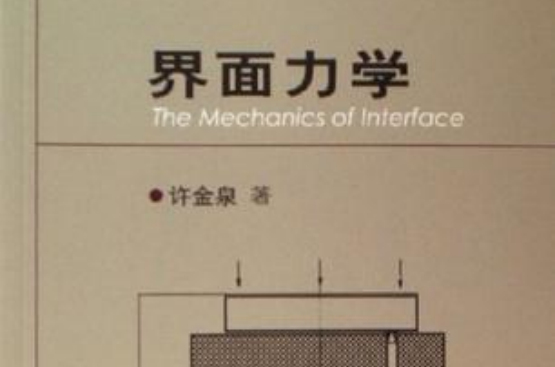內容介紹
《界面力學》簡介:界面是先進材料和結構中普遍存在的異種或同種材料間的結合部,破壞一般從界面或其附近開始,對其分析和評價必須採用新的界面力學理論體系。《界面力學》從界面的力學建模、界面問題的分析方法,到結合材料的強度、可靠性評價以及工程套用,系統地介紹了界面力學理論。有關界面力學的研究,是目前固體力學、材料科學等學科的研究熱點之一。

圖書信息
作者:黃平、郭丹、溫詩鑄
出版社:清華大學出版社
ISBN:9787302336280
定價:68元
印次:1-1
裝幀:精裝
印刷日期:2013-10-21
圖書簡介
本書共11章。第1章緒論,介紹界面的分類、形成和本書的主要內容。後10章分為兩篇。固體界面力學篇和受限流體界面力學篇。固體界面力學篇,共6章,介紹了固體接觸力學、界面滑動分析、界面黏著滑動、界面接觸剛度、滾動分析和接觸疲勞力學等內容。本篇對界面滑動、摩擦理論、黏滑等現象和產生原因做了分析。分析了不同接觸條件下的接觸剛度,介紹了純滾、滑滾、滾動疲勞破壞等現象和機理。受限流體界面力學篇,共4章,首先分析了流體在界面上的吸附解附機理和濕潤性對界面性能的影響。然後對當前常用的求解界面流體力學問題的三種方法——雷諾方程、分子動力學和玻耳茲曼輸運方程做了介紹。之後介紹了有序分子膜、LB膜和液晶的潤滑機理和性能。最後,本書還對邊界層的形成界面滑移現象做了較深入的探討,介紹了由邊界滑移導致的性能變化。
本書可以作為從事界面科學工作者的參考用書,也可以作為相關專業高年級本科生和研究生的教學用書。
書籍目錄
第1章緒論
1.1界面分類
1.1.1光滑與粗糙界面
1.1.2界面間的介質
1.1.3不同物質間的界面
1.1.4界面組成的尺度比較
1.2界面形成
1.2.1表面接觸
1.2.2表面變形
1.3表面運動與受力
1.3.1表面運動
1.3.2表面受力
1.4粗糙表面
1.4.1表面形貌參數
1.4.2表面形貌的統計參數
1.5本書的內容與構成
1.5.1本書的內容
1.5.2本書的構成
參考文獻
第1篇固體界面力學
第2章固體接觸
2.1赫茲彈性接觸理論
2.1.1赫茲線接觸理論
2.1.2赫茲一般接觸理論
2.2非赫茲彈性接觸
2.2.1接觸表面不連續
2.2.2協調錶面接觸
2.2.3界面摩擦對接觸應力的影響
2.2.4表面效應的影響
2.3粗糙表面接觸
2.3.1單峰接觸
2.3.2理想粗糙表面接觸
2.3.3隨機粗糙表面的接觸
2.3.4塑性指數
2.4彈塑性接觸
2.4.1屈服判據
2.4.2彈性體接觸屈服力和屈服載荷
2.4.3理想剛塑性固體的接觸
2.4.4彈塑性壓入
參考文獻
第3章界面滑動分析
3.1無滑動面接觸
3.2滑動面接觸
3.2.1滑動摩擦基本定律
3.2.2摩擦界面靜力學
3.3彈性變形摩擦界面力學
3.3.1基本假設
3.3.2切應力對壓力分布的影響
3.3.3局部區域滑動
3.4粗糙變形摩擦界面力學
3.4.1等高球體粗糙彈性接觸
3.4.2隨機粗糙表面接觸
3.5滑動摩擦特性
3.5.1靜止接觸時間
3.5.2躍動現象
3.5.3預位移
參考文獻
第4章界面黏著滑動
4.1固體界面能
4.1.1固體表面力場
4.1.2固體表面能和表面張力
4.1.3固體界面能
4.2固體摩擦振動與黏滑
4.2.1摩擦振動
4.2.2黏滑現象
4.2.3黏滑與減噪
4.3黏著影響因素
4.3.1粗糙度的影響
4.3.2表面微結構的影響
4.4壁虎黏著研究
4.4.1壁虎剛毛微觀結構
4.4.2壁虎微細結構的黏附機理
4.5固體材料表面處理與改性
4.5.1固體表面增黏處理
4.5.2固體表面的減黏防污
4.5.3表面清潔
4.5.4機械處理與熱處理
4.5.5表面改性技術
參考文獻
第5章界面接觸剛度
5.1兩體接觸剛度
5.1.1接觸剛度的定義
5.1.2球體接觸剛度
5.1.3正交圓柱接觸剛度
5.1.4一般接觸剛度
5.1.5平行圓柱接觸
5.2多體接觸剛度
5.2.1組合接觸剛度
5.2.2止推軸承接觸剛度
5.2.3徑向軸承接觸剛度
5.3粗糙界面接觸剛度
5.3.1等高粗糙接觸剛度
5.3.2隨機粗糙接觸剛度
參考文獻
第6章滾動分析
6.1純滾運動
6.1.1滾動摩擦係數
6.1.2滾動摩擦機理
6.2滑滾運動
6.2.1巨觀滑滾運動及滑滾比
6.2.2微觀滑動
6.2.3從微觀滑動到巨觀滑動
6.3黏滑牽引機制
6.3.1固固界面間的黏著功
6.3.2黏附理論——球/平面接觸模型
6.3.3滾動區域內的黏著
6.3.4影響輪軌黏著的因素
6.4其他滾動摩擦理論
6.4.1彈性遲滯理論
6.4.2塑性變形理論
參考文獻
第7章接觸疲勞力學
7.1表面疲勞
7.1.1表面疲勞磨損的種類
7.1.2裂紋的起源與擴展
7.2接觸疲勞分析
7.2.1接觸應力狀態
7.2.2接觸疲勞強度準則
7.2.3接觸疲勞壽命
7.3疲勞磨損理論與計算
7.3.1疲勞磨損理論
7.3.2剝層磨損理論
7.3.3磨損計算方法
7.4影響疲勞磨損的因素
7.4.1載荷性質
7.4.2材料性能
7.4.3潤滑劑的物理與化學作用
7.4.4摩擦副材料的選配
參考文獻
第2篇受限流體界面力學
第8章界面膜
8.1吸附現象
8.1.1氣固界面吸附
8.1.2液固界面吸附
8.1.3表面膜強度
8.2表面濕潤性
8.2.1表面張力與接觸角
8.2.2表面張力引起的液體內部壓力
8.2.3濕潤性對界面膜性能的影響
8.2.4濕潤性對黏著的影響
8.3表面膜吸附熱力學
8.3.1液體吸附熱力學
8.3.2解附臨界溫度
參考文獻
第9章受限流體模型與分析
9.1界面流體流動分析模型
9.1.1連續流體介質
9.1.2非連續流體介質
9.1.3統計力學
9.2利用連續流體介質力學求解界面問題
9.2.1流體動壓潤滑分析
9.2.2彈性流體動壓潤滑分析
9.3利用分子動力學模擬求解界面問題
9.3.1分子動力學模擬方法
9.3.2粗粒珠簧模型與勢能函式
9.3.3PFPE在光滑表面上的鋪展現象
9.4利用玻耳茲曼方程求解稀薄氣體潤滑方程
9.4.1基本方程
9.4.2邊界條件
9.4.3任意克努森數的廣義潤滑方程推導
9.4.4稀薄效應對負壓型磁頭性能的影響
參考文獻
第10章受限薄膜
10.1有序分子膜類型
10.1.1分子自組裝膜
10.1.2LB膜
10.1.3分子沉積膜
10.2有序分子膜性能
10.2.1有序分子膜性能的實驗研究
10.2.2分子結構對自組裝膜性能的影響
10.2.3濕度和水膜對自組裝膜摩擦性能的影響
10.2.4超薄分子膜摩擦耗散的微觀機制
10.3液晶膜
10.3.1液晶化合物的分類
10.3.2液晶潤滑分析
10.3.3液晶潤滑添加劑的摩擦機理
參考文獻
第11章流固界面邊界層分析
11.1邊界層滑移
11.1.1邊界滑移現象
11.1.2滑移邊界條件
11.1.3滑移邊界流速分布
11.2邊界滑移理論
11.2.1滑移長度模型
11.2.2極限剪應力滑移模型
11.2.3界面滑移的影響因素
11.3考慮稀薄氣體效應的雷諾方程
11.3.1流量分析
11.3.2廣義雷諾方程
11.3.3磁頭/磁碟超薄氣體潤滑計算
11.4界面滑移測試技術
11.4.1近界面流體速度直接測量
11.4.2基於微管道流量的測量
11.4.3基於液體壓力的測量
參考文獻
中英文對照及索引
Contents
Chapter 1Introduction
1.1Interface classification
1.1.1Smooth and rough interface
1.1.2Interface with medium
1.1.3Fluidsolid interface
1.1.4Scale comparision of interface compositions
1.2Interface formation
1.2.1Surface contact
1.2.2Surface deformation
1.3Surface movement and action on interface
1.3.1Surface movement
1.3.2Action on interface
1.4Rough surface
1.4.1Parameters of surface topogragh
1.4.2Statistic parameters of surface topogragh
1.5Contents and compositions of the book
1.5.1Contents of the book
1.5.2Compositions of the book
References
Part I Solid interface mechanics
Chapter 2Solid contact
2.1Hertz contact theory
2.1.1Hertz contact theory in line contact
2.1.2Hertz contact theory in point contact
2.2NonHertz contact of elastic solid
2.2.1Contact of noncontinuous surface
2.2.2Coordination surface contact
2.2.3Interfacial friction effect on contact stress
2.2.4Surface effect on contact
2.3Rough surface contact
2.3.1Single peak contact
2.3.2Ideal rough surface contact
2.3.3Random rough surface contact
2.3.4Plasticity index
2.4Elastoplastic contact
2.4.1Yield criteria
2.4.2Yield strength and yield load of elastic contact
2.4.3Ideal rigidplastic solid contact
2.4.4Elasticplastic indentation
References
Chapter 3Analysis of interface sliding
3.1Non sliding surface contact
3.2Sliding surface contact
3.2.1Fundamental laws of sliding friction
3.2.2Sliding interface mechanics analysis
3.3Friction interface mechanics of elastic deformation
3.3.1Basic assumptions
3.3.2Effect of shear stress on pressure
3.3.3Local sliding
3.4Friction interface mechanics of rough deformation
3.4.1Elastic contact of equal high balls
3.4.2Elastic contact of random roughness
3.5Characteristics of sliding friction
3.5.1Static contact time
3.5.2Jerking phenomenon
3.5.3Premovement
References
Chapter 4Interface adhesive sliding
4.1Solid interface energy
4.1.1Solid surface force field
4.1.2Solid surface energy and surface tension
4.1.3Solid interface energy
4.2Solid friction vibration and stickslip
4.2.1Friction vibration
4.2.2Stickslip phenomenon
4.2.3Stickslip and noise reduction
4.3Affecting factors of adhesion
4.3.1Roughness effect
4.3.2Surface microstructure effect
4.4Adhesion study of gecko
4.4.1Micro structure of gecko setae
4.4.2Adhesion mechanism of micro structure of gecko
4.5Surface treatment and modification of solid materials
4.5.1Solid surface thickening
4.5.2Solid surface visbreaking and antifouling
4.5.3Surface cleaning
4.5.4Mechanical and thermal treatment
4.5.5Surface modification technology
References
Chapter 5Interface contact stiffness
5.1Two objects contact stiffness
5.1.1Contact stiffness definition
5.1.2Spherical bodies contact stiffness
5.1.3Orthogonal cylinders contact stiffness
5.1.4General contact stiffness
5.1.5Parallel cylinders contacts
5.2Multi object contact stiffness
5.2.1Combination contact stiffness
5.2.2Thrust bearing contact stiffness
5.2.3Radial bearing contact stiffness
5.3Rough interface contact stiffness
5.3.1Equal high roughness contact stiffness
5.3.2Random roughness contact stiffness
References
Chapter 6Rolling analysis
6.1Pure rolling movement
6.1.1Rolling friction coefficient
6.1.2Rolling friction mechanism
6.2Slidingrolling movement
6.2.1Macro slidingrolling movement and slidingrolling ratio
6.2.2Micro sliding
6.2.3From micro slide to macro slide
6.3Stickslip traction mechanism
6.3.1Adhesion energy of solid interface
6.3.2Adhesion theoryballflat contact model
6.3.3Adhesion in rolling area
6.3.4Influence factors on wheelrail adhesion
6.4Other rolling friction theories
6.4.1Elastic hysteresis theory
6.4.2Plastic deformation theory
References
Chapter 7Contact fatigue mechanics
7.1Surface fatigue damage
7.1.1Types of surface fatigue wear
7.1.2Origination and expansion of crack
7.2Analysis of contact fatigue
7.2.1Contact stress state
7.2.2Contact fatigue strength criteria
7.2.3Contact fatigue life
7.3Theory and computation of fatigue wear
7.3.1Theory of fatigue wear
7.3.2Theory of delamination wear
7.3.3Wear calculation methods
7.4Impact factors of fatigue wear
7.4.1Load nature
7.4.2Material properties
7.4.3Physical and chemical actions of lubricant
7.4.4Matching of friction materials
References
Part IIRestricted fluid interface mechanics
Chapter 8Adsorption film
8.1Adsorption phenomena
8.1.1Adsorption of gassolid interface
8.1.2Adsorption of liquidsolid interface
8.1.3Strength of surface film
8.2Surface wettability
8.2.1Surface tension and contact angle
8.2.2Internal pressure caused by surface tension of liquid
8.2.3Influence of wettability on interfacial film performance
8.2.4Influence of wettability on adhesion
8.3Thermodynamics of adsorption of liquidsolid surface film
8.3.1Liquid adsorption thermodynamics
8.3.2Critical temperature of desorption
References
Chapter 9Confined fluid models and analysis
9.1Interface fluid flow analysis model
9.1.1Continuous fluid medium
9.1.2Noncontinuous fluid medium
9.1.3Statistic mechanics
9.2Solve interface problem by continuous fluid mechanics
9.2.1Hydrodynamic lubrication analysis
9.2.2Elastohydrodynamic lubrication analysis
9.3Solve interface problem by molecular dynamics simulation
9.3.1Molecular dynamics simulation method
9.3.2Coarse ballspring model and potential energy function
9.3.3Spreading phenomenon of PFPE on a smooth surface
9.4Solve rarefied gas lubricated equatione problem by Boltzmann
equation
9.4.1Basic equations
9.4.2Boundary conditions
9.4.3Generalized lubrication equation with arbitrary Knudsen
number
9.4.4Influence of rarified effect on performances of negtive
magnetic head
References
Chapter 10Confined thin film
10.1Types of ordered molecular film
10.1.1Selfassembled molecular monolayer
10.1.2LB film
10.1.3Deposition molecular film
10.2Performances of ordered molecular film
10.2.1Experimental study on performances of ordered
molecular film
10.2.2Molecular structure on selfassembled film performance
10.2.3Humidity and water film on selfassembled film
frictional performance
10.2.4Microscopic friction dissipation mechanism of
super thin molecular film
10.3Liquid crystal film
10.3.1LCD compounds classification
10.3.2LCD lubrication analysis
10.3.3Friction mechanism of LCD lubricant additive
References
Chapter 11Boundary layer analysis of fluidsolid interface
11.1Slip of boundary
11.1.1Boundary slip phenomenon
11.1.2Boundary conditions of slippage
11.1.3Velocity distribution on slip boundary
11.2Boundary slip theory
11.2.1Slip length model
11.2.2Slip model of limiting shear stress
11.2.3Factors affecting on boundary slip
11.3Reynolds equation considering effect of rarefied gas
11.3.1Flow analysis
11.3.2Generalized Reynolds equation
11.3.3Calculation of head/disk ultra thin gas lubrication
11.4Technology of interfacial slippage testing
11.4.1Direct measurement of fluid velocity near interface
11.4.2Flow measurement based on micropipeline
11.4.3Pressure measurement for liquid
References
ChineseEnglish List and Index


